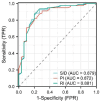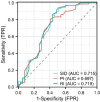The Correlation Between Fetal Wellbeing and Umbilical Doppler Parameters in Pregnant Women with Gestational Hypertension
- PMID: 40224281
- PMCID: PMC11994114
- DOI: 10.2147/IJWH.S514427
The Correlation Between Fetal Wellbeing and Umbilical Doppler Parameters in Pregnant Women with Gestational Hypertension
Abstract
Objective: To investigate the role of umbilical cord blood flow parameters in evaluating intrauterine fetal hypoxia and fetal growth restriction in pregnant women with gestational hypertension.
Methods: One hundred and nine patients with gestational hypertension admitted from January 2020 to December 2023 were enrolled in this study. The peak systolic velocity/end diastolic velocity (S/D), pulse index (PI) and resistance index (RI) of cord blood were measured by ultrasound. According to the S/D, 109 cases were divided into 62 cases in the control group (S/D < 3) and 47 cases in the observation group (S/D ≥ 3), and the prognosis of pregnant women and fetuses in the two groups were compared. The ROC curves were used to analyze the effects of different parameters of umbilical blood flow on intrauterine fetal hypoxia and fetal growth restriction in pregnant women with gestational hypertension.
Results: The incidence of intrauterine fetal hypoxia, fetal growth restriction, cesarean section, and unresponsive type of non-irritation test was decreased in the control group compared with the observation group (P < 0.05). However, there was no statistical difference in the incidence of neonatal asphyxia between the two groups (P > 0.05). ROC curve analysis showed that cord blood flow RI of pregnant women with gestational hypertension had the highest sensitivity and AUC in predicting intrauterine fetal hypoxia and growth restriction, and PI had the highest specificity in predicting intrauterine fetal growth restriction. The specificity of S/D, PI and RI in predicting intrauterine hypoxia was consistent (all 80%).
Conclusion: The different parameters of umbilical blood flow in hypertensive pregnant women during pregnancy provide a good assessment of intrauterine fetal condition and can be used as clinical indicators to predict poor prognosis of intrauterine fetal hypoxia and fetal growth restriction.
Keywords: assessment; gestational hypertension; growth restriction; hypoxia; umbilical blood flow.
© 2025 Lin et al.
Conflict of interest statement
The authors declared that they have no conflicts of interest regarding this work.
Figures





Similar articles
-
Relationship between ultrasound parameters of the umbilical and middle cerebral arteries and intrauterine fetal distress.World J Clin Cases. 2024 Jun 6;12(16):2745-2750. doi: 10.12998/wjcc.v12.i16.2745. World J Clin Cases. 2024. PMID: 38899299 Free PMC article.
-
[Prognostic Doppler ultrasound examination of fetal arteries blood flow].Ginekol Pol. 2002 Aug;73(8):677-84. Ginekol Pol. 2002. PMID: 12369294 Polish.
-
[Comparison of Doppler examination and non-stress test in the prediction of intrauterine fetal hypoxia].Zhonghua Fu Chan Ke Za Zhi. 2002 Apr;37(4):214-6. Zhonghua Fu Chan Ke Za Zhi. 2002. PMID: 12133413 Chinese.
-
Clinical significance of umbilical artery intermittent vs persistent absent end-diastolic velocity in growth-restricted fetuses.Am J Obstet Gynecol. 2022 Sep;227(3):519.e1-519.e9. doi: 10.1016/j.ajog.2022.06.005. Epub 2022 Jun 10. Am J Obstet Gynecol. 2022. PMID: 35697096
-
Fetal arterial Doppler-IUGR and hypoxia.Eur J Obstet Gynecol Reprod Biol. 1997 Dec;75(1):51-3. doi: 10.1016/s0301-2115(97)00202-9. Eur J Obstet Gynecol Reprod Biol. 1997. PMID: 9447347 Review.
References
-
- Yuriah S, Kartini F. Factors affecting with the prevalence of hypertension in pregnancy: scoping review. Hypertension. 2022;7:3.
LinkOut - more resources
Full Text Sources
Research Materials
Miscellaneous

